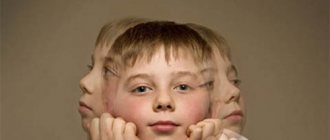© Narrated by Andrey Arkadyevich Shmilovich
, Doctor of Medical Sciences, doctor of the highest category, head of the Department of Psychiatry and Medical Psychology, Russian National Research Medical University named after. N.I. Pirogova, chief physician of the Alter clinic:
Today in the series on comparative age aspects of mental disorders we will talk about mental disorders of childhood
.
We will talk about pre-pubertal age, that is, up to approximately 10–12 years, during which the child goes through several stages of his psychophysical development. This is a very important age from the point of view of the development of his mental functions, his personality, and character. This age also has its most significant periods. They are distinguished by the special vulnerability of the child’s psyche to external social, sometimes pathogenic factors. These periods of particular vulnerability are called age-related crises.
In childhood, age-related crises are well known to psychiatrists, psychologists, and teachers - these are the ages of 3 years and 7 years.
Formation of the first communication connections
At the age of 3, the child finds himself on the threshold of kindergarten. When, on one of the joyful days of September 1, his mother takes him to some strange institution, in which for some reason he must be without his parents for quite a long time, surrounded by very strange people who are similar to him, and even some kind of aunt , calling herself “the educator,” demands that he fulfill the requirements that are necessary.
This age is very important from the point of view of the formation of the child’s first communicative connections with peers. It is at this age, at 3 years old, that the first rudiments of role identity appear. The child begins to recognize himself as an individual and identify himself as an individual, separate from those around him. Finds in himself those traits that are not in others, and finds in others those traits that he does not have. He begins to understand the difference between himself and others, the first signs of his individuality are formed.
This is a very important period, and personally, I categorically do not advise ignoring preschool institutions, kindergartens, sports sections, clubs, where the child has the opportunity to develop a sufficient number of communication skills.
Children at home who sit with their grandparents around the clock and only go out in good weather to the sandbox in the yard are much less well adapted to school than those children who in preschool age had the opportunity to establish communicative connections and form their social role.
Neurotic disorders of childhood
During this period, the child is stressed, he may have a large number of various types of neurotic disorders. And we know these disorders well. enuresis may suddenly appear
– urinary incontinence, we can observe bitten nails in these children. These children may experience a large number of fears; they refuse to sleep in a separate room with the lights off; even if they are forced to sleep in the nursery, they still find the opportunity to sneak into their parents’ bedroom at night and crawl under their blanket.
These children very often develop behavior problems
in case they face quite a lot of stress factors. And kindergarten teachers pay attention to these behavior problems. Sleep disturbances, bad mood, tearfulness, capriciousness, loudness, sometimes excessive demonstrativeness, posturing may appear - we call all this childhood neuroses or childhood neuroses.
Children do not display such neurotic symptoms as we are used to seeing in adults, because their affective emotional sphere has not yet matured, and they cannot experience this or that difficult life situation the way adults do, so most often they react with their bodies.
Children have a very developed psychosomatic reaction
. Their neuroses, as a rule, are of a somatic nature. As I already said, enuresis is one of the types of childhood neuroses. There is also stuttering - this, too, in 90% of cases is attributed to the psychological neurotic problems of the child. This also includes various kinds of conditioned diseases; most likely, they can be found in the form of symptoms from the gastrointestinal tract. Children may experience pain symptoms that are not confirmed by examinations.
Sometimes children experience what is called aspiration syndrome.
, when at the moment of just such another violent emotional reaction they suddenly begin to choke, they experience bronchospasm, the question arises that perhaps this is bronchial asthma. Well, and many, many other such polymorphic, unusual things that happen to children precisely during their age-related crises.
Symptoms of mental disorder
Each mental illness begins with the appearance of various symptoms, which, as a rule, one at a time do not raise any special questions from others and it can be difficult to collect them all into a single picture. However, careful observation of a person over several days will allow us to draw conclusions for taking further measures.
Symptoms of mental disorders in most cases are closely related to a person’s depressed state, which prevents him from performing daily routine activities. These symptoms include:
- physical (sleep disturbance, both in the direction of insomnia and vice versa, constant loss of strength even after proper rest; headache, etc.);
- behavioral (abuse of pills, cigarettes and other substances in large quantities, inability to perform work);
- cognitive (inability to think clearly, memory problems);
- perceptual (obsessive thoughts);
- emotional (constant feelings of anxiety and sadness).
The presence of several symptoms immediately indicates a problem and the need for professional consultation with a psychologist or psychotherapist. Identifying the causes and the possibility of making a diagnosis in the early stages will help quickly get a person out of such an undesirable state.
Problems of school maladjustment
There is also a 7-year-old crisis. This is the age when a child starts school. And here he gains even more independence, here he begins to understand what responsibility is, begins to receive the inclinations of ideas about legal capacity, that is, the idea that his actions have some consequences, and these consequences are connected specifically with him.
At this age, the child is also quite vulnerable. First-graders can stumble already in the first months of school, we call this the problem of school maladaptation
. They are unable to establish connections with classmates, constant disagreements arise with the teacher, they refuse to go to school, they throw tantrums right in class, interfere with everyone’s learning by getting up from their seats, not realizing that they are not allowed to walk around the class. The reaction of teachers means nothing to them; this leads to a serious conflict with many participants in the school process, not only with classmates and teachers, but also with the school principal. And parents are also starting to take part in this.
Many parents take the child’s side, considering him undeservedly offended. They see the problem in the incompetence of teachers and begin to blame teachers, often adding fuel to the fire of these neurotic symptoms and behavioral disorders that I have already mentioned.
Mental disorders in children
As every child goes through certain stages of his life, he faces a lot of problems and challenges. Some people endure all the difficult periods, but there are also those who are not ready for such conditions. Mental disorders in children can begin under the pressure of various factors.
- The formation process is often accompanied by the child’s rejection of himself and his own body. This causes various behavioral reactions, such as overeating or, conversely, refusing to eat. This eating disorder can lead to anorexia or bulimia.
- Peer bullying. Once one person stands out, he becomes a target for others. School bullying causes nervousness, psychosis, and depression. Suicidal thoughts may appear.
- Tense situation in the family. A very common cause of mental disorders in children is an unhealthy environment. If constant violence occurs in front of a child, then a mental disorder is guaranteed and can subsequently cause the development of schizophrenia. In an attempt to escape from reality, children invent a different life for themselves and stop this process, especially in an advanced stage. It can be extremely difficult.
- Congenital mental disorders of children can be caused by genetic predisposition, as well as unacceptable behavior of parents at the time of bearing the baby.
Early mental illness. Mental retardation
In addition to neurotic disorders, quite serious mental illnesses can also begin in childhood, among which today, perhaps, we can classify two diseases as the most common of all other mental disorders of childhood.
The first disease is called mental retardation
. Unfortunately, it happens quite often. If we are talking about severe forms of mental retardation, then it attracts attention even in the first years of life. If we are talking about its mild or borderline forms, then this only manifests itself when the child goes to school, and from the first days he does not keep up with his peers in mastering the material.
Mental retardation can be different; there are many reasons for its occurrence. Among them are many different kinds of neurological or therapeutic, pediatric diseases that the child suffers from very early infancy. Or which started a little later. These include traumatic brain injuries, and some kind of neuroinfections, perhaps some kind of genetic, hereditary, chromosomal pathology, which leads to underdevelopment of the central nervous system and, accordingly, to mental disorders in the form of mental retardation.
Children with mental retardation are more vulnerable to neurotic symptoms, since in the case of mild mental retardation they understand and realize the fact of their inadequacy and see how they lag behind their peers. And they very often find themselves at the center of so-called bullying. Peers begin to mock them, painfully making fun of their odd behavior.
In these situations, when we are dealing with mental retardation, it is very important to promptly resolve the issue of the form of education, to what extent this form in a regular comprehensive school will be comfortable for the child himself if he does not have time there. And how much easier it will be for him to study in a school where the requirements for the educational process are somewhat different, and they are close to the individual, as we say, Waldorf requirements.
Signs of mental disorder
The peculiarity of mental illness is that there are no conditions, ages, nationalities or races for them. Absolutely every person, especially in the current world of multitasking and constant stress, is susceptible to threat. You can recognize the signs of a mental disorder with some careful observation of the behavior of others and your own.
- No matter how crazy you go. Everyone has fear - of newness, forgetfulness, a pressing deadline, natural disasters and other similar things. Constant thoughts around what a person is afraid of, together with a series of nervous situations at home or at work, can cause neurosis and panic attacks. And when mental health is shaky, psychosomatics can also get involved. In such a set it is difficult to find the root cause, and the neglected process can result in a more serious mental illness.
- Absent-mindedness. Conditions of constantly tight deadlines have a strong impact on the nervous system. It’s simply physically impossible to do everything, and you become distracted and forgetful. The nervous system cannot cope with overstrain and fails. As a result, the development of a mental disorder.
- Not good enough. Beauty standards, fashion canons, and high standards lead to the emergence of a whole complex of mental illnesses. This includes depression, eating disorders and psychosis. N
- Addiction. In addition to addiction to various alcoholic and psychotropic substances, which cause many mental disorders, psychologists have found that workaholism can also lead to unwanted diseases. Constant immersion in work matters, sleep disturbances and emotional burnout are slowly and surely preparing another person who needs the help of a psychotherapist.
Autism Spectrum Disorders
The second most common mental disorder in childhood is autism spectrum disorder. Abbreviated as RAS. The structure of these disorders includes many different types of clinical units. One of the most striking and classic manifestations of autism spectrum disorder was described at one time by the domestic psychiatrist Grunya Efimovna Sukhareva and her foreign colleague Hans Asperger.
This form is now called Asperger's syndrome.
, that is, early childhood autism syndrome, in which a rather pronounced asynchrony of the child’s mental development occurs. In his development, we see a significant acceleration in relation to peers of intellectual, cognitive functions, and to a significant extent a lag in relation to emotional and volitional functions.
The personality of such a child is formed in a deformed way; he ultimately finds himself deprived of the mental capabilities for communication with peers. He has no choice but to withdraw into his own inner world, which is called the “autistic world.” Autistic world
- this is the world of his fantasies, attitudes, known very often only to him. Help for such a child can only be provided by a specialist who has managed to at least somehow look into this world, not to mention getting into this world and understanding its laws.
People with mental disorders
As already mentioned, every person is susceptible to mental illness to varying degrees. Unfortunately, a healthy lifestyle and careful treatment of the nervous system cannot always guarantee the effect of “vaccination” against such diseases. People with mental disorders are not always the ones you often see in films. Not everyone wears white straitjackets, hears voices and sees things that others don't. Most people suffering from mental disorders are ordinary passersby whom you can meet on the way to work, neighbors at the nearest table in a coffee shop, and even friends and family. However, there are also more serious forms of the disease.
Atypical childhood autism
In addition to Asperger's syndrome, autism spectrum disorders also include other variants: Kanner's syndrome, Geller's syndrome - this is the so-called atypical childhood autism. We begin to talk about atypical childhood autism when, against the background of autistic manifestations, some psychopathological phenomena begin to appear in a child, indicating to us the onset of some kind of mental illness. For example, he begins to have some hallucinations, or he becomes so detached from what is happening that he generally stops reacting to what is happening around him and “freezes” - this is the so-called catatonia syndrome. However, a complete picture of mental illness does not emerge. And these symptoms are ultimately reversible.
We must remember that early childhood autism and all autism spectrum disorders are a very ambiguous group in prognostic terms. In particular, there are options that have a fairly favorable prognosis; literally, all manifestations of autism completely disappear with age and appropriate treatment. At the other pole are those forms of childhood autism that, with age, unfortunately transform into current mental illnesses, more typical of adolescence or adulthood.
Mental disorders in adults
Most mental health problems in adults arise and develop against the general background of dissatisfaction with life, as well as particular stressful situations that can be accompanied both in the family and at work.
Bipolar disorder has gained widespread popularity because the number of patients it reaches is frightening. The disease manifests itself through frequent uneven mood swings, when a person, from vigorous activity, is transferred to a period of complete powerlessness, with the inability to eat, move and continue a full life.
Another most common mental disorder in adults is depression. Despite the fact that psychologists have long been trumpeting the danger of this disease, modern society still does not pay due attention to it and subsequently specialists have to treat more advanced forms that the person himself is not able to cope with.
Schizophrenia. May arise from dissociative identity disorder or as a separate disorder. As a rule, the disease develops against a background of disharmony and a tense nervous state over a long period of time, but schizophrenia can also develop on a completely stable neurological basis.
Women, as a separate category, are more susceptible to mental disorders than men. The most common diseases include manic-depressive psychosis, eating and sexual behavior disorders, delirium and alcohol addiction, nervousness and panic attacks.
Onset of adult mental illness. Childhood form of schizophrenia
In addition, in childhood we can, unfortunately, observe the onset of adult mental illness. It is rare, however, that childhood forms of schizophrenia
. Its course is usually very difficult, unfavorable and malignant. In these cases, the child finds himself at the mercy of very severe painful symptoms when he hears voices or sees some visual images that cause him certain fears. When he, being in this psychotic state, hides from these ghosts, which seem very dangerous to him and are present somewhere nearby.
It is practically impossible to establish any contact with this child on a verbal level. The only way to help is to hospitalize him in a children's psychiatric hospital. Such hospitals exist; they specialize specifically in childhood mental illnesses, when specialists in this case have experience working specifically with children.
Favorable treatment prognosis
There are also many other mental illnesses, it is almost impossible to cover everything. The only thing that needs to be said is that children with certain mental disorders, as a rule, are treated quite well, that is, it is sometimes possible to achieve much greater results with them than with adults. But only under one condition: if their relatives, especially parents, who are extremely concerned about the health of their child, agree with psychiatrists that their beloved child needs the help of a child psychiatrist.
Child psychiatry, as a rule, uses not only medical, that is, purely psychiatric technologies, with medications or some other methods of treatment. Psychologists are mostly involved in child psychiatry. Family psychologists conducting group psychotherapy, teachers, various kinds of educators, defectologists, speech therapists, and pediatricians participate in the provision of assistance. As a rule, this is a whole multi-professional team that takes on the child’s health and which jointly solves various aspects of his problem.
Seeking medical help in such a situation will greatly facilitate the task of diagnosis, since in child psychiatry there are many methods, including very accurate, almost 100% methods for diagnosing certain mental illnesses.
For example, genotyping is very widely used, when we can with a high degree of probability diagnose a particular disease associated with a mutation or genetics. The main thing is that the child is in the field of view of specialized specialists. The main thing is that he receives the medical care he needs on time in order for his future life to be healthy.
Organic diseases of the brain (in particular cerebrasthenic syndrome)
The diagnosis of “organic brain damage” has recently become very common. This is due to the fact that this formulation describes not one disease, but a number of individual pathologies. All of them are characterized by changes in the structure of the brain. In most cases, organic changes do not have a significant effect on the functioning of the central nervous system; pronounced symptoms begin to appear if more than 20% of the brain is damaged. With more serious injuries, persistent pathological syndromes appear, one of them is cerebrasthenic syndrome.
In children, organic brain damage is most often associated with intrauterine infections or birth injuries. But other reasons can also lead to the development of organic diseases. Cerebrasthenic syndrome develops as a result of oxygen starvation of the brain. The patient cannot concentrate and absorb large amounts of information and gets tired quickly.
Cerebroasthenic syndrome can develop at any age.
If the problem is ignored, the child’s psyche does not develop at a normal pace, but modern medicine allows for successful treatment. Children with various organic brain injuries today have a chance to recover and lead a full life in the future.









